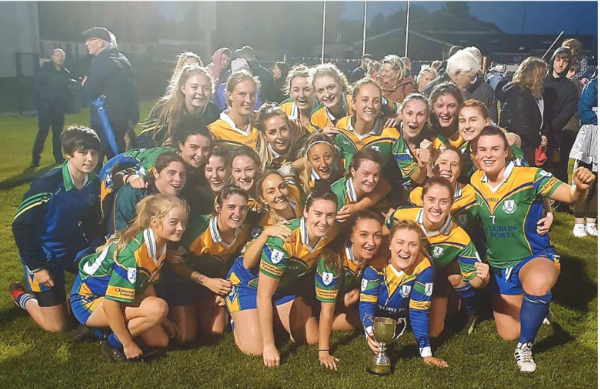
Clanns ladies: 2019 Dublin Inter-mediate Football Champions and Leinster semi finalists
Felix O’Regan
The break in playing activity due to the Covid-19 pandemic has allowed us to stand back and to take stock. This has included a look back to some notable events of the past which have helped to make the club what it is today for its players, supporters and the wider communities of Ringsend, Irishtown and Sandymount especially.
History shows, for example, that while our adult male footballers have not won the Dublin Senior Football Championship in some time, they did so in 1968, 1948, 1937 and 1936. In addition, they contested a further five finals in 1949, 1953, 1957, 1962 and 1963 – the latter going to a replay which Clanns eventually lost by four points to UCD. The club’s four Dublin titles actually equal the total number amassed by such strong footballing clubs as Ballyboden St Endas and Ballymun Kickhams. Today our adult men are faring very well at Intermediate level and building successfully towards senior-level status again; while our recently-reformed Junior football team has surpassed all expectations.
Championship football success has been a more recent affair for our adult ladies, with their winning the Dublin Intermediate Championship for the very first time in 2010, a feat they have since repeated in 2019. They are now playing their football at senior level and holding their own with such powerhouses of the game as Kilmacud Crokes, Ballyboden St Endas, Clontarf and St Brigids. A Senior County Championship title beckons!
Momentous history
The year 1968 was momentous for the club as the year in which Clanna Gael (founded in 1929) merged with Fontenoy (founded in 1887) to form the club as we know it today. Indeed, the latter has a chequered history all of its own, with links to the Belgian town of Fontenoy, scene of a major battle in 1745 as part of the War of the Austrian Succession between the French on the one hand and the British and Dutch on the other. It’s reported that the Ringsend/Irishtown/Sandymount area was well represented in the Irish Brigade which was central to delivering victory for the French. The very first meeting of the Fontenoy club is recorded as taking place at No. 20 Bath Avenue on October 7th 1887.
The year 1968 was also the last time Clanns were crowned Dublin senior football champions. That victorious team comprised a good mix of players from different parts: mainly from the Ringsend and Irishtown areas, a number from Valentia Island as well as students from St Patrick’s Primary Teaching Training College. One member of that team, Mick Byrne, would go on to become physio to the international soccer team under Jack Charlton and Mick McCarthy. Others were already household names throughout the city, having helped Dublin to win the All-Ireland in 1963: Mickey Whelan, Paddy Holden, Gerry Davy, Chris Kane, Aidan Donnelly and Tony Gilleen. As well as a player, Mickey Whelan would subsequently feature prominently with Dublin footballers as manager 1995-97 and as selector under Pat Gilroy.
Another of that team stood out for his previous exploits with the Dublin football team – Gerry Davey, known as the “Irishtown Hero” as recalled by Finbarr Dolan.
The Irishtown Hero
Clanna Gael and St. Vincents were dominating club football in 1963, so both teams were watched regularly to see what players they could provide to the Dublin team. The average age then of inter-county players was 25 plus, but it was 19-year-old Gerry Davey from Clanna Gael who really caught the eye.
He grasped his chance during Dublin’s league campaign, while in the championship he played his part when called upon as starter or substitute – demonstrating a physical and mental toughness way beyond his years. The Dubs brushed aside Meath, Kildare, Laois, and Down on the way to the All-Ireland final with Galway; and it came as no surprise to see Gerry Davey named at number 11 for that big game.
On All-Ireland final day he didn’t break with tradition, travelling alone on the No. 3 bus to the city centre and walking the remaining distance to Croke Park. Members of the Davey household were among the 87,000 who flocked to Jones Road. The match was a tight and tense affair, played in a sporting manner, hard but fair as play switched from end to end. Half time saw Galway leading six points to four. The half-time dressing room had no stats men no physios , no clip boards , no TVs for re-runs of plays. What was there was a group of players and mentors with a huge determination to bring Sam back to the capital.
The teams took their positions for the second half and what was to come would never be forgotten: Dublin on the attack into the Hill 16 end, they work the ball forward and Gerry Davey scores a vital goal to turn the tide in their favour. He recalls the noise from the stands and the terraces, the way the whole team fought for their lives for the remaining minutes. Eventually, the referee blows the final whistle and for the “Irishtown Hero” the rest is a blur, lost in the crowd and the sheer excitement of a 1-9 to 0-10 victory.
A trip to Glendalough was the reward for the squad on the Monday and schools were visited over the next number of weeks as a motivation for future generations. Gerry Davey got to keep his jersey – but, sadly, this was subsequently stolen. In 1970 he retired from inter-county football in the knowledge that he would forever be known as the “Irishtown Hero”.



